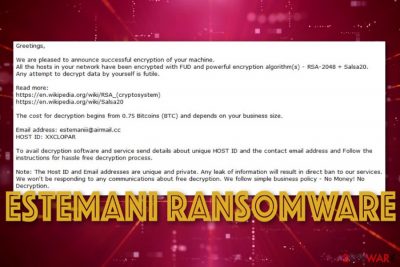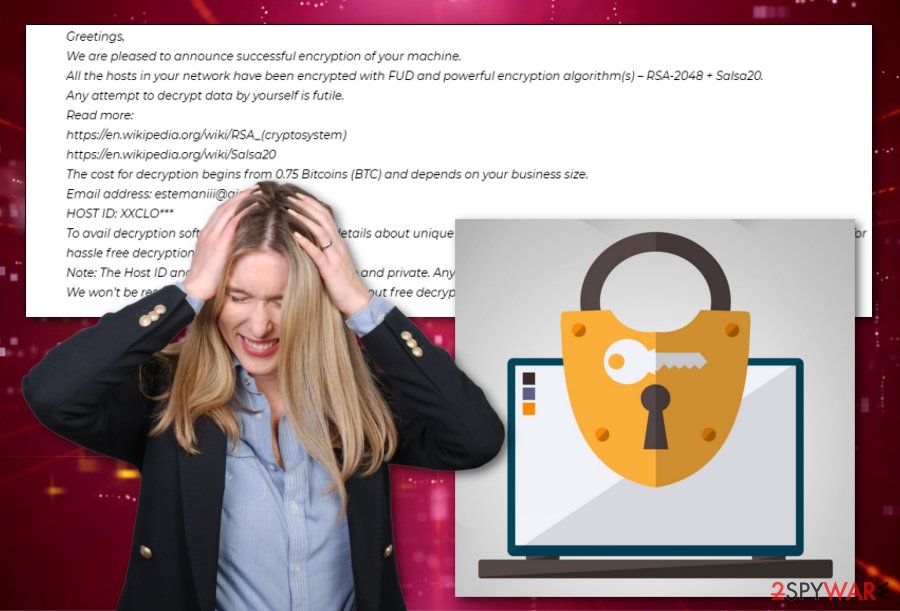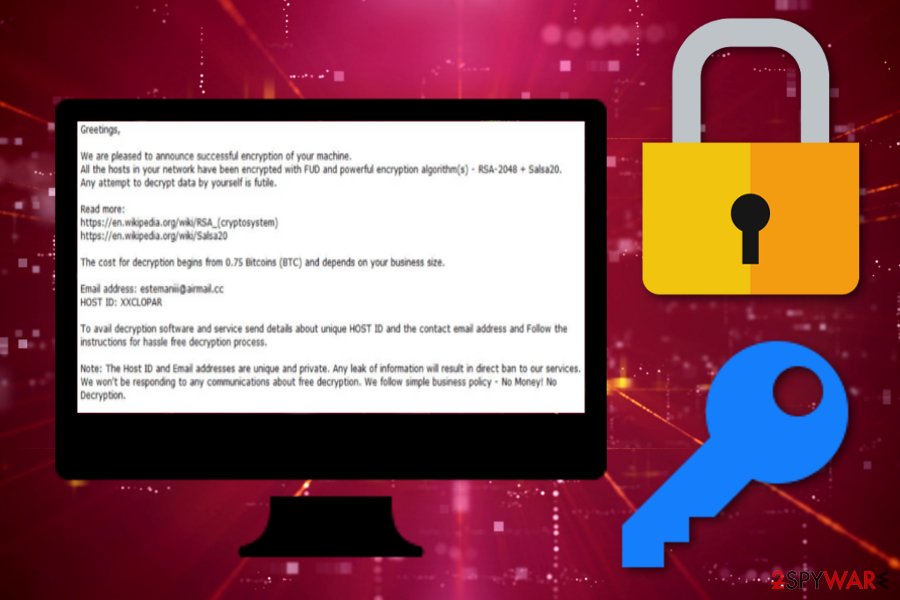Estemani ransomware (Improved Instructions) - Virus Removal Guide
Estemani virus Removal Guide
What is Estemani ransomware?
Estemani ransomware – a file-locking threat that adds no extension to encrypted data

Estemani ransomware is a ransom-demanding malware that emerged at the second have of August and appears to encrypt data by adding no appendix to the file names. However, criminals focus on English-speaking users and aim to launch an English-based ransom message that comes in a text document named HOW_DECRYPT_FILES.txt. The spreaders of Estemani virus announce that various files have been locked with the mixture of RSA 2048 and Salsa20[1] algorithms and the only way to reverse them back to their previous states is by purchasing the decryption software straightly from the hackers for a price of 0.75 BTC. Additionally, the estemaniii@airmail.cc email address is provided as the way to contact the crooks.
| Name | Estemani |
|---|---|
| Type | Ransomware |
| Appendix | No extension is added to the locked files |
| Note | HOW_DECRYPT_FILES.txt |
| Price | 0.75 BTC is urged for the data recovery software |
| estemaniii@airmail.cc is the way to contact the hackers | |
| Target | English-speaking people |
| Cipher used | RSA 2048 and Salsa20 |
| Removal | Use FortectIntego to discover all malware-laden objects on your computer system. Continuously, use only automatical software to remove the ransomware virus |
Estemani ransomware might carry a more complex module than we might think. For example, some ransom-demanding threats are capable of erasing Shadow Volume Copies and making the decryption process harder to carry out so that the victims will end up buying the crooks' offered decryption software instead.
In addition, some malware such as Estemani ransomware can carry other malware attached to themselves. This way you can end up with a notorious Trojan horse or cryptocurrency miner on your computer system. Avoid such dangerous possibility by terminating the ransomware virus immediately.
Besides, do not fall for believing in the claims that are provided by Estemani ransomware as you cannot be guaranteed that by paying the demanded ransom price you will truly receive the decryption tool. Here is how the message looks like:
Greetings,
We are pleased to announce successful encryption of your machine.
All the hosts in your network have been encrypted with FUD and powerful encryption algorithm(s) – RSA-2048 + Salsa20.
Any attempt to decrypt data by yourself is futile.
Read more:
https://en.wikipedia.org/wiki/RSA_(cryptosystem)
https://en.wikipedia.org/wiki/Salsa20
The cost for decryption begins from 0.75 Bitcoins (BTC) and depends on your business size.
Email address: estemaniii@airmail.cc
HOST ID: XXCLO***
To avail decryption software and service send details about unique HOST ID and the contact email address and Follow the instructions for hassle free decryption process.
Note: The Host ID and Email addresses are unique and private. Any leak of information will result in direct ban to our services.
We won’t be responding to any communications about free decryption. We follow simple business policy – No Money! No Decryption.
Estemani ransomware removal can be carried out with the help of automatical software. However, first, you have to reboot in Safe Mode with Networking to ensure that no malicious processes are running on your computer system. Continuously, perform a full machine scan with FortectIntego to locate all malware-laden objects.

Estemani ransomware is not the type of program to play with as the longer you keep it on your computer, the bigger the damage might be. Besides, keep in mind that you might find malicious processes left by this malware in the Windows Task Manager and Windows Registry[2] sections in the form of entries, keys, files, tasks, etc.
After you remove Estemani ransomware, you can take a look at the data recovery software that we have provided at the end of this article. Furthermore, note that precautionary measures for avoiding similar incidents in the future are necessary to take. Keep on reading and figure out what kind of steps you can take to move towards full machine safety.
Email spam – the most liked place by ransomware spreaders
Experts from Virusai.lt[3] claim that email spam campaigns are the ones that spread ransomware viruses and other malware forms very often. Due to this fact, it is very important to manage all of your received emails. This means, identifying the sender, checking the message for possible grammar mistakes, scanning all attached files with antivirus software.
In addition, the malicious payload can be delivered through unsecured domains of gambling, online-dating, gaming, and porn-watching websites. Here you need to be careful of questionable-looking hyperlinks and adverts. However, the best thing to do would be not to visit such directories ever at all.
Continuously, installing reliable security software into your computer system is also a necessary step to take. Choose a reputable tool and ensure that you update it regularly, otherwise, the program might start failing.

Estemani ransomware removal + decryption process
Estemani ransomware removal is a necessary step to take before you start thinking about data recovery possibilities. Note that the automatical technique is the only way to get rid of the dangerous cyber threat as manual elimination has been found to be an unsafe and struggling task for many users. Besides, scanning the entire system for potential infection sources is also a good thing to do. Carry out the process with FortectIntego, SpyHunter 5Combo Cleaner, or Malwarebytes.
After you remove Estemani ransomware and infection strings are lurking in your system no more, you can start viewing data restoring solutions that are presented below this paragraph. Besides, keep in mind that you have to protect your future information also. For this purpose, purchasing a portable drive and keeping files there is a good choice to make. Also, you can drag copies of important data to a remote server, for example, iCloud or Dropbox.
Getting rid of Estemani virus. Follow these steps
Manual removal using Safe Mode
Use Safe Mode with Networking to disable malicious processes ongoing in the background. Here are the instructions to follow:
Important! →
Manual removal guide might be too complicated for regular computer users. It requires advanced IT knowledge to be performed correctly (if vital system files are removed or damaged, it might result in full Windows compromise), and it also might take hours to complete. Therefore, we highly advise using the automatic method provided above instead.
Step 1. Access Safe Mode with Networking
Manual malware removal should be best performed in the Safe Mode environment.
Windows 7 / Vista / XP
- Click Start > Shutdown > Restart > OK.
- When your computer becomes active, start pressing F8 button (if that does not work, try F2, F12, Del, etc. – it all depends on your motherboard model) multiple times until you see the Advanced Boot Options window.
- Select Safe Mode with Networking from the list.

Windows 10 / Windows 8
- Right-click on Start button and select Settings.

- Scroll down to pick Update & Security.

- On the left side of the window, pick Recovery.
- Now scroll down to find Advanced Startup section.
- Click Restart now.

- Select Troubleshoot.

- Go to Advanced options.

- Select Startup Settings.

- Press Restart.
- Now press 5 or click 5) Enable Safe Mode with Networking.

Step 2. Shut down suspicious processes
Windows Task Manager is a useful tool that shows all the processes running in the background. If malware is running a process, you need to shut it down:
- Press Ctrl + Shift + Esc on your keyboard to open Windows Task Manager.
- Click on More details.

- Scroll down to Background processes section, and look for anything suspicious.
- Right-click and select Open file location.

- Go back to the process, right-click and pick End Task.

- Delete the contents of the malicious folder.
Step 3. Check program Startup
- Press Ctrl + Shift + Esc on your keyboard to open Windows Task Manager.
- Go to Startup tab.
- Right-click on the suspicious program and pick Disable.

Step 4. Delete virus files
Malware-related files can be found in various places within your computer. Here are instructions that could help you find them:
- Type in Disk Cleanup in Windows search and press Enter.

- Select the drive you want to clean (C: is your main drive by default and is likely to be the one that has malicious files in).
- Scroll through the Files to delete list and select the following:
Temporary Internet Files
Downloads
Recycle Bin
Temporary files - Pick Clean up system files.

- You can also look for other malicious files hidden in the following folders (type these entries in Windows Search and press Enter):
%AppData%
%LocalAppData%
%ProgramData%
%WinDir%
After you are finished, reboot the PC in normal mode.
Remove Estemani using System Restore
You might have a chance of preventing bogus tasks from spreading further by opting for System Restore on your Windows computer:
-
Step 1: Reboot your computer to Safe Mode with Command Prompt
Windows 7 / Vista / XP- Click Start → Shutdown → Restart → OK.
- When your computer becomes active, start pressing F8 multiple times until you see the Advanced Boot Options window.
-
Select Command Prompt from the list

Windows 10 / Windows 8- Press the Power button at the Windows login screen. Now press and hold Shift, which is on your keyboard, and click Restart..
- Now select Troubleshoot → Advanced options → Startup Settings and finally press Restart.
-
Once your computer becomes active, select Enable Safe Mode with Command Prompt in Startup Settings window.

-
Step 2: Restore your system files and settings
-
Once the Command Prompt window shows up, enter cd restore and click Enter.

-
Now type rstrui.exe and press Enter again..

-
When a new window shows up, click Next and select your restore point that is prior the infiltration of Estemani. After doing that, click Next.


-
Now click Yes to start system restore.

-
Once the Command Prompt window shows up, enter cd restore and click Enter.
Bonus: Recover your data
Guide which is presented above is supposed to help you remove Estemani from your computer. To recover your encrypted files, we recommend using a detailed guide prepared by 2-spyware.com security experts.If your files are encrypted by Estemani, you can use several methods to restore them:
Data Recovery Pro software can help you with file restoring purposes:
If you have been looking for ways to restore files and documents that have been encrypted by Estemani ransomware virus, you should give this piece of software a try.
- Download Data Recovery Pro;
- Follow the steps of Data Recovery Setup and install the program on your computer;
- Launch it and scan your computer for files encrypted by Estemani ransomware;
- Restore them.
Use Windows Previous Versions feature for data recovery tasks:
If you have launched System Restore in the past and disabled malicious activities on your Windows machine, you can try using this technique for restoring some of your files.
- Find an encrypted file you need to restore and right-click on it;
- Select “Properties” and go to “Previous versions” tab;
- Here, check each of available copies of the file in “Folder versions”. You should select the version you want to recover and click “Restore”.
Shadow Explorer might allow you to restore documents back to their previous states:
Use this technique for file restoring purposes. If you need some help with this tool's usage, take a look at the guidelines provided below.
- Download Shadow Explorer (http://shadowexplorer.com/);
- Follow a Shadow Explorer Setup Wizard and install this application on your computer;
- Launch the program and go through the drop down menu on the top left corner to select the disk of your encrypted data. Check what folders are there;
- Right-click on the folder you want to restore and select “Export”. You can also select where you want it to be stored.
Currently, no official Estemani decryptor has been discovered/released.
Finally, you should always think about the protection of crypto-ransomwares. In order to protect your computer from Estemani and other ransomwares, use a reputable anti-spyware, such as FortectIntego, SpyHunter 5Combo Cleaner or Malwarebytes
How to prevent from getting ransomware
Access your website securely from any location
When you work on the domain, site, blog, or different project that requires constant management, content creation, or coding, you may need to connect to the server and content management service more often. The best solution for creating a tighter network could be a dedicated/fixed IP address.
If you make your IP address static and set to your device, you can connect to the CMS from any location and do not create any additional issues for the server or network manager that needs to monitor connections and activities. VPN software providers like Private Internet Access can help you with such settings and offer the option to control the online reputation and manage projects easily from any part of the world.
Recover files after data-affecting malware attacks
While much of the data can be accidentally deleted due to various reasons, malware is one of the main culprits that can cause loss of pictures, documents, videos, and other important files. More serious malware infections lead to significant data loss when your documents, system files, and images get encrypted. In particular, ransomware is is a type of malware that focuses on such functions, so your files become useless without an ability to access them.
Even though there is little to no possibility to recover after file-locking threats, some applications have features for data recovery in the system. In some cases, Data Recovery Pro can also help to recover at least some portion of your data after data-locking virus infection or general cyber infection.
- ^ Salsa20. Wikipedia. The free encyclopedia.
- ^ Tim Fisher. What Is the Windows Registry?. Lifewire.com. Independent news source.
- ^ Virusai.lt. Virusai. Spyware news.





















